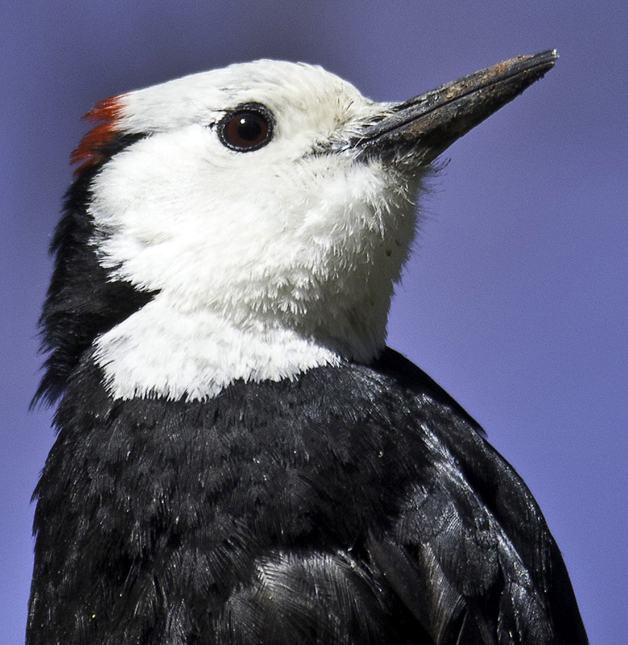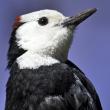Bird Name Color-by-Numbers
Among North American birds, what color descriptor word is found in most bird names? Maybe it was the grayness of the day that got us thinking about colors, but over breakfast this morning we discussed this very question, making various guesses and trying to think of the names of various birds. Then we remembered that with the new bird guide phone apps, it’s possible to type in a color and see how many species show up on the list. Our guesses? Either “black” or “white.”
As it turns out, both appear in a long list of bird names. The word “white” appears in the name of our familiar white-breasted nuthatch and in more southern birds like the American white pelican and white ibis, winter visitors white-winged scoters, two of our favorite sparrows—the white-throated sparrow and white-crowned sparrow. In fact, our Sibley “Birds of North America” app showed 29 species with “white” in the name (we didn’t count “bobwhite” since the name is really a description of their call). The word “black” is in names like black-capped chickadee, all of the blackbirds, black guillemot, and the black-backed gulls (be they greater or lesser), black-backed woodpecker, several black-throated warblers, and various others. Our bird guide app gave us an amazing 55 species with the word “black” in the name!
How about some other colors that you might think of as commonly appearing in bird names? Red, for instance? There are red-throated loons, red-necked grebes, red-breasted mergansers, red knots. There are five woodpeckers with red in the name including the red-bellied and red-headed woodpeckers. Several have red in the name in more unusual ways, as in redstart and redpoll. There is even one named for the unique color of its eyes: the red-eyed vireo. Surprisingly to us, this list came to 39 species—even more than “white.”
“Yellow” tied with “white” at 29 species, perhaps no surprise given the number of warblers that have yellow in their plumage AND in their name. Incidentally, one of our favorite “yellow” bird names is the yellow-eyed junco, which we searched for on a memorable worldwind trip to southwestern New Mexico years ago. How about “blue?” Bluebirds may be the most adored of birds with “blue” in their names but, but there are 17 others; don’t forget the blue jay, blue grosbeak, the great blue and little blue herons, and the black-throated blue warbler.
We could find only three species of North America with “orange” in the name and only one of those, orange-crowned warbler, is a native species. Birds so brightly green-colored that the word “green” would appear in the name seem to be more common in tropical regions. Many of the 10 “green” North American birds are from Texas or farther south—green kingfisher, green jay, yellow-green vireo, and green violetear, to name a few. Here in Maine we do have the diminutive green heron and the green-winged teal.
We can’t overlook “brown,” since we know that here in our state we can find brown creepers, brown thrashers, and brown-headed cowbirds. Still, the total list of “brown” birds only comes to a grand total of 10. Easily overlooked could be “gray” despite the fact that this list includes favorites like gray catbird and northern boreal specialties like great gray owl, gray jay, and gray-cheeked thrush. Once you add to this list some of the western and southwestern North American birds like black-throated gray warbler and the wonderfully named gray-crowned rosy-finch, the tally of “gray” birds comes to.13.
We couldn’t leave out the charismatic “purple birds.” There may be only four of them but they include purple gallinule (of the southeastern U.S. and tropics), purple sandpiper (currently wintering on the Maine coast), purple martin (wintering right now in the Amazon Basin), and purple finch (perhaps you’ve got them at your feeder this winter?).
Two colors appear in only two bird names: “scarlet” and “roseate,” and Maine is blessed to have one of each in the summers, the scarlet tanager and the roseate tern.
Wonder how many colors are in the names of all the world’s birds?
Guess we’ll have some homework to do to answer that one!
Jeffrey V. Wells, Ph.D., is a Fellow of the Cornell Lab of Ornithology. Dr. Wells is one of the nation's leading bird experts and conservation biologists and author of “Birder’s Conservation Handbook”. His grandfather, the late John Chase, was a columnist for the Boothbay Register for many years. Allison Childs Wells, formerly of the Cornell Lab of Ornithology, is a senior director at the Natural Resources Council of Maine, a nonprofit membership organization working statewide to protect the nature of Maine. Both are widely published natural history writers and are the authors of the book, “Maine’s Favorite Birds” and the newly published “Birds of Aruba, Bonaire, and Curaçao” from Cornell Press.
Event Date
Address
United States
























